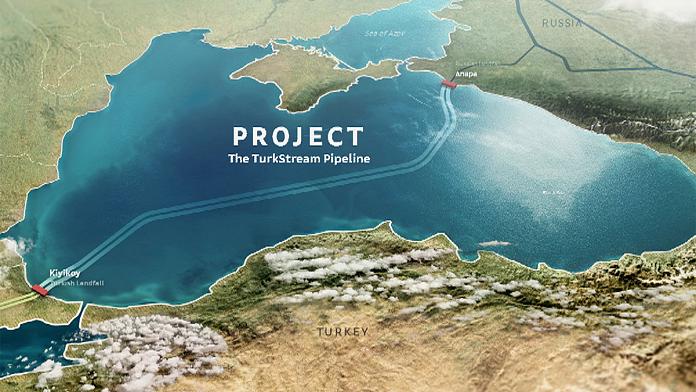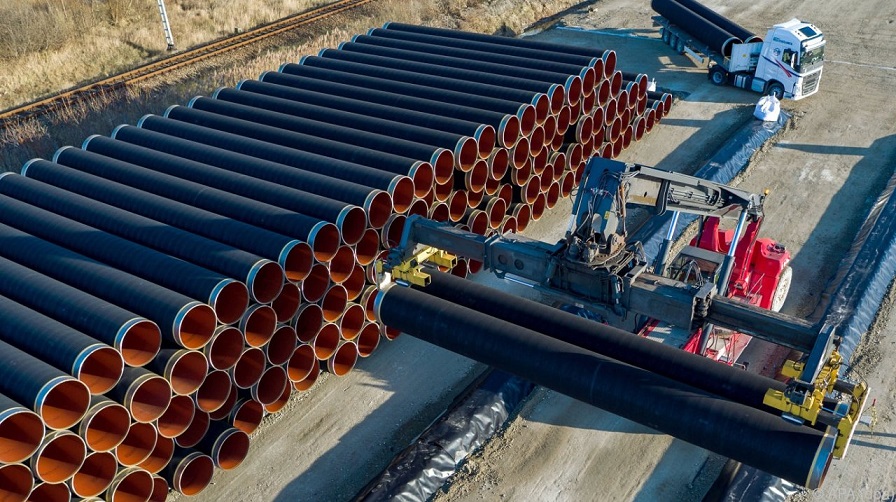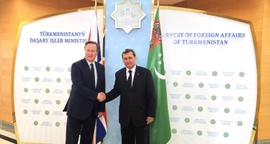Russian energy giant Gazprom completed on November 4 laying down 448 km (278 mi) of pipe that will form the twin TurkStream offshore gas pipeline.
The project, which will measure a total of 930 km (578 mi) in length, is estimated to cost $6 billion, is designed to carry around 31.5 billion cubic meters (bcm) of natural gas annually through the lines which will cross the Black Sea.
"The Pioneering Spirit, the world’s largest construction vessel, [has] laid into the sea the pipe sections, with the Russian and Turkish flags, which symbolize the crossing of the exclusive economic zone’s border between the countries," said a Gazprom project operator, according to Russia’s TASS news agency.
TurkStream is made up of two offshore pipelines, each with a capacity to carry up to 15.75 bcm of gas per year. The offshore project extends from the Russian Black Sea coastal city of Anapa to the Turkish town of Kiyikoy, some 157 km (97 mi) north of Istanbul.

The pipeline is expected to come online by December 2019. Gas that will move through the first of the twin lines is destined for Turkey’s domestic consumption, and the second line will deliver gas for consumers further west, in Europe.
TurkStream is replacing another of Russia’s energy infrastructure developments, namely the South Stream project, which was expected to run through Bulgaria. Russia scrapped plans for South Stream in 2014 over the European Union’s lack of support and an energy crisis in Ukraine.
Heavily dependent on oil and gas revenues, Moscow has been aggressively pushing and promoting the construction of TurkStream, widely viewed as being critical to its market share in Europe’s energy sector, amid a cutthroat race with other gas-exporting countries.
Russia refuses to proceed with extending TurkStream into EU territory, however, until it receives legal assurances from it, according to Russian Foreign Minister Sergey Lavrov.
“The growing energy needs of Southern and South-Eastern Europe could be met by the extension of the second branch of the Turkish Stream to the EU territory. Many governments of EU states have shown considerable interest in this,” Lavrov said, according to the Russian newspaper Vedomosti.
“We are open to this, but considering the unfortunate experience of the South Stream, we will start this work only after receiving firm legal guarantees from Brussels,” he added.
TurkStream could become an important new source of energy for Europe, as its member states are struggling to meet the demands of the continent’s ever-increasing needs. Europe imports over 50 percent of its energy demand from outside of its borders, meaning its economic security relies on partnerships and agreements with countries outside its bloc.
TurkStream also signifies what are changing regional and global priorities. Two years ago this month, when Moscow and Ankara were in the midst of a major diplomatic row over the latter’s downing of a Russian jet on the Syrian border, it would have been unimaginable to think of the two countries moving ahead with such an ambitious project.
The completion of the Russian segment of the pipeline on schedule, at a time when the Kremlin is in dire need of hard currency, indicates Moscow’s determination to move forward with the project and hedge against ambitious competitors, such as those in Azerbaijan.
The construction of the EU-backed Southern Gas Corridor, which pumps gas from underneath the Caspian Sea and starts in Azerbaijan and consists of three pipelines that run through Georgia, Turkey, Greece, Albania and plugs into Europe in southern Italy, is considered a competitor to TurkStream. However, TurkStream will transport substantially larger volumes of gas than the Southern Gas Corridor.
Both pipelines target the same markets and can compete in terms of gas volumes, market share in the consumer states along their respective routes, and for regional geopolitical significance.
For example Greece, which is participating in the corridor project, has already expressed interest in buying Russian gas from TurkStream, hoping to enhance the country’s role as one of the main gas hubs in Europe and attract international investors to Greece’s struggling economy.
On the other hand, the EU and Azerbaijan have taken steps to attract additional gas suppliers to feed into the Southern Gas Corridor to make it more commercially viable and geopolitically significant. Turkmenistan is a likely supplier, as it holds the world’s sixth largest proved reserves of natural gas. Lying along the eastern shore of the Caspian Sea it can link up with the Southern Gas Corridor via the Trans Caspian Pipeline, which will carry around 30 bcm of gas annually from Turkmenistan to Azerbaijan.







 Turkmen President Serdar Berdimuhamedow and British Secretary of State for Foreign Affairs, Commonwealth Affairs, and Development David Cameron dis...
Turkmen President Serdar Berdimuhamedow and British Secretary of State for Foreign Affairs, Commonwealth Affairs, and Development David Cameron dis...
 A draft resolution aimed at preventing the development and deployment of weapons of mass destruction (WMDs) in outer space, co-sponsored by Japan a...
A draft resolution aimed at preventing the development and deployment of weapons of mass destruction (WMDs) in outer space, co-sponsored by Japan a...
 Russia and Ukraine have engaged in direct negotiations facilitated by Qatar to address the exchange of children affected by the ongoing conflict.
Russia and Ukraine have engaged in direct negotiations facilitated by Qatar to address the exchange of children affected by the ongoing conflict.



